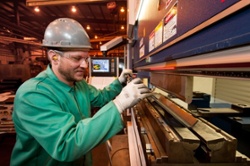
4 Practices That Make Your Structural Metal Fabricator A Lean, Mean Machine
November 17, 2017
 Imagine how smoothly your production line would operate if your metal manufacturing could achieve exponentially high-quality standards for near-defect-free components in the quantity you requested, when you need them.
Imagine how smoothly your production line would operate if your metal manufacturing could achieve exponentially high-quality standards for near-defect-free components in the quantity you requested, when you need them.
That’s the promise of lean manufacturing, which helps to improve OEM component manufacturing productivity, quality and lead time by eliminating waste and creating seamless part flow. Based on the Japanese concept of kaizen, meaning “change for the better” or “good change,” lean manufacturing is also a methodology of continuous improvement.
Although some of the items below are not “official” lean manufacturing practices, here are four practices your supplier should follow to become a lean, mean machine:
1. Smart Information Flow
According to lean manufacturing principles, production is steady and predictable when work is flowing. If the flow is blocked, then work starts and stops. A direct relationship exists between getting work to flow efficiently and increasing profitability.
Consistent flow ensures reliable parts assembly, delivery and value for your customers. One of the seven types of flow in lean manufacturing is information flow.
Through time studies and other tools, employees can be empowered to understand how to optimally carry out tasks based on determined production procedures and rates in order to reduce waste.
2. Smart Inventory
Determining appropriate inventory levels is a challenge. From a simplistic view, carrying too much inventory ties up available resources. If you carry too little inventory, fluctuating customer demand, forecast inaccuracy and variability in lead times can cause stockouts.
Without the components you need in stock, your production can come to a halt, and your customer service is affected. However, strategic safety stock can eliminate most stockouts.
As most OEMs have seasonal businesses and demand variations, production of a certain number of parts every day and keeping extra stock at times can be a smart inventory strategy. This allows your supplier to plan for labor and equipment requirements more easily. The extra inventory also serves as an emergency backup in case your demand increases unexpectedly.
Even better, the opportunity to leverage the value-added inventory management services of your structural metal fabrication partner can ensure that your supply is accurately replenished while offsetting the risks of managing such a process. To learn more about these value-added services, sign up for the free webinar, “Maximizing the Inventory Capabilities of Your Contract Metals Manufacturer.”
3. 5S Methodology
When researchers began studying 5S in Japanese manufacturing companies over 25 years ago, they found equipment was so clean that workers could spot a loose bolt or leaking oil easily.
A clean and well-organized workplace cuts back on costs associated with low productivity. For example, when everything is in the correct place, operators spend less time searching for tools or navigating around displaced material and equipment.
The methodology drastically elevates workstation efficiency. The 5S’s include:
- Sort – Get rid of items you no longer need, such as old or broken tools, fixtures, workbenches, pallets and scrap material.
- Straighten – Put items back in order in a particular work cell to ensure the workspace has the best, most ergonomic layout.
- Shine – Scrub machines, paint walls and fix floors. Get rid of oils, coolants and greases that may be leaking, giving the operator time to inspect an area.
- Standardize – Create shadow boards and designate specific locations for parts.
- Sustain – Conduct audits, create checklists and continue looking for ways to improve the visual organization of a work area.
4. Part Flow
If you visit an OEM component manufacturing facility and notice parts sitting around that are not being worked on, it can be a sign that the supplier doesn’t have good part flow.
Lean practices ensure that people are working on the right part at the right time, enabling a single-piece flow.
The move from batch-and-queue processing to a single-piece flow was the focus of an article from The Fabricator, underlining the point that no single adjustment is going to produce dramatic results for your OEM business. Real change requires a systematic approach within your structural metal fabrication partner.
Ready to learn how Miller can help you keep production lines at capacity with the right parts at the right time? Contact us today.